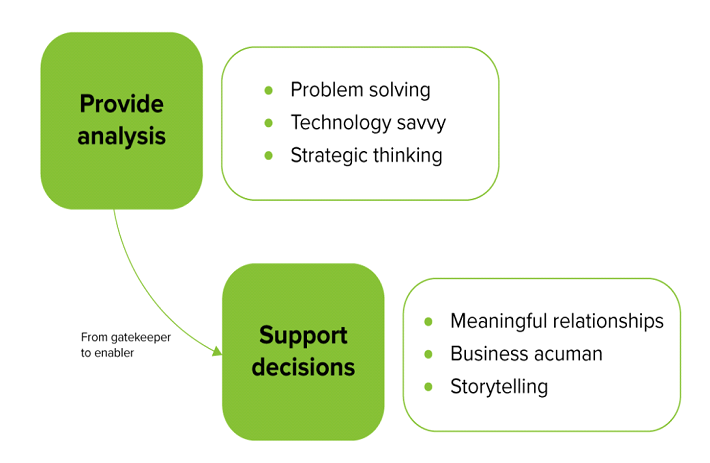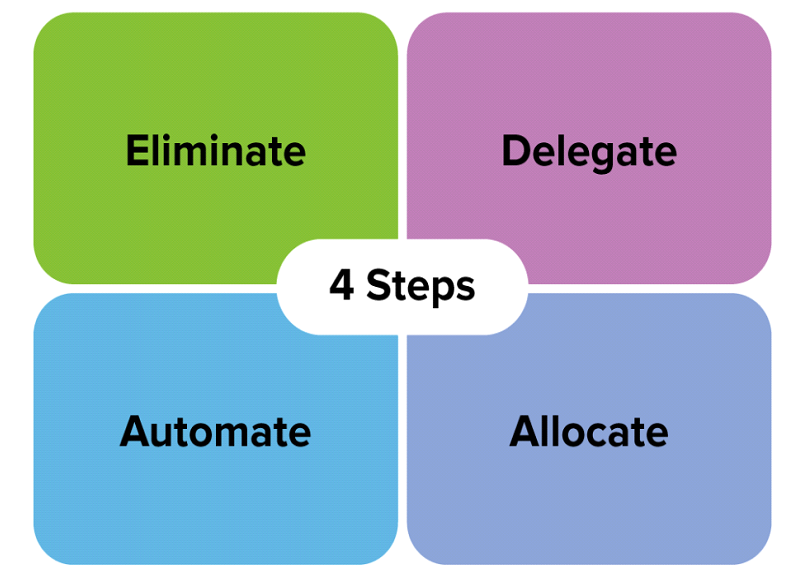Your FP&A team needs to act fast, adopt a business partnering mindset, and leverage digital analytics to provide relevant business insights. Five key pillars enable financial planning and analysis skills to shift from gatekeeper to enabling
The 5 pillars of FP&A leaders:
Let’s take a look at the five pillars of transforming and enabling the FP&A
1. Mindset
The shift in your FP&A department’s mindset starts with repositioning FP&A skills as a value creator (profit center), not only as a value protector (cost center). It should be about having the curiosity to understand what exists behind numbers and the ingenuity to build business relationships. FP&A teams need to have the courage to coach stakeholders by asking them the right questions in order to validate business assumptions and get a sense of the numbers. This is an example of a forward-looking mindset that encourages questions like “so what?” and “what if?” Modern FP&A professionals should strive to provide decision-makers with options, scenarios, and predictions, not only historical data analysis.
Another important shift in mindset is to move from communicating behind the screen towards hosting face-to-face meetings with stakeholders. This helps foster a productive conversation, builds rapport and avoids misunderstandings and misinterpretations arising through emails. FP&A can achieve simplicity and build trust by thinking from a stakeholder’s perspective and presenting complex financials in simple, clear messages. Moving away from technical finance terminologies will help FP&A deliver messages with impact.
2. Skillset
FP&A teams need to develop specific soft and hard skills to succeed as credible and trusted business partners. These skills can group into two broad categories: analysis and decision support.

To provide solutions to stakeholders and solve their business problems, FP&A departments need to have sufficient problem-solving skills. In addition, in a data-driven world, teams need to be tech-savvy and be able to simplify, automate, integrate and quickly analyze data.
This helps, especially in organizations that have adopted predictive planning and other innovations. To provide the business with strategic direction, let them ask the right FP&A questions their teams need to know to work on their strategic thinking and try to understand the complexity, volatility, and ambiguity of both the internal environment and the external one.
The skills required to gain buy-in from stakeholders and secure influence are the ability to build meaningful relationships and learn business acumen. If FP&A teams are able to understand what stands behind the numbers, they can deliver insights directly to stakeholders and support their decisions.
But these are not the only skills or approaches you’ll need to make your FP&A team true enablers. They will also need to understand the latest best practices out there. Take a look at some of these in our article on Important FP&A techniques and processes you need to know.
Though it is important to remember that Owning and reporting on your numbers is not enough. Your FP&A team needs to be able to explain the numbers to the business in a way that they will understand. They have to transform numbers into narratives and inspire action through stories. And they will need to bring together their storytelling and FP&A skills to align people with business objectives in compelling ways.
Also, your FP&A team’s career path should not stop at analysis or problem solving. By providing clear, precise and transparent messages and turning complex analytics into simple and impactful messages, your FP&A experts will become a set of valued and trusted advisors to the business.
3. Digitalization
Finance digitalization entails the integration of multiple technologies and strategies that enable your finance function to deliver value in the digital age. This means your FP&A department needs to leverage digitalization through multiple areas in order to succeed as a business enabler. Some examples include:
⦁ Automation. Generate greater efficiencies and free up time to create more strategic value for the business. For example, adopt robotics process automation (RPA).
⦁ Cloud. Adopt user-friendly enterprise performance management (EPM) cloud solutions to provide stakeholders with self-service access to data and insights. This helps decision-makers make fast decisions no matter where they are.
⦁ Digital. Create customized real-time reports to suit every different stakeholders’ need. They turn complex numbers into simple messages through effective visualization tools.
⦁ Machine learning and artificial intelligence (AI). Use on data sets to apply advanced predictive and prescriptive analytics and support strategic decision-making.
What all these digitalization capabilities do is help make your FP&A team more agile and adaptable. You can find out more about how in our article on Building a flexible and dynamic FP&A function.
4. Capacity
If you hired the best talents in the market and implemented the best technology ever, your FP&A would still not add value to the business until you freed up their time to interact effectively and at length with all the other functions. There are four ways to help FP&A teams free up their time

⦁ Eliminate. Review the full task list of the FP&A team and eliminate all unnecessary reports and low value add tasks from their daily workloads.
⦁ Automate. Automate all other possible repetitive, high volume, and low value add activities from your FP&A team’s task list.
⦁ Delegate. Assign any remaining low value add activities to a third-party or shared service team.
⦁ Allocate. Align with the business on key business priorities and strategic objectives in order to re-allocate the FP&A team’s time most effectively.
5. Culture
One of the key pillars that enables your FP&A team to succeed is the implementation of the right culture in the organization. There are three types of cultures that should be considered: ethics and compliance, collaboration, and diversity.
The most important one is the ethics and compliance culture. It entails integrity, trust, due care and respect. These are a must in any organization and should be ingrained into all facets of what you do. The second one is collaboration culture. By encouraging cross-functional teamwork, organizations boost all functions and add value while ensuring that they are not working in silo. Finally, the diversity culture must be built through establishing a diversified more FP&A team whose members have different personalities, backgrounds, experience and skills, which gives you broader abilities and perspectives.
How these 5 pillars transform your FP&A team.
The 5 pillars for building a winning FP&A function include:
⦁ Adopting a business partner mindset
⦁ Developing skills to influence decision making
⦁ Implementing technology to empower the team
⦁ Maintaining a healthy work environment and culture for the FP&A team to succeed.
For any questions or comments, please reach out to me at:
www.linkedin.com/in/elrouby
“This article was first published on:
https://www.unit4.com/blog/5-pillars-building-fpa-teams-moving-gatekeepers-enablers







